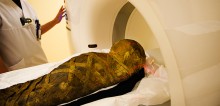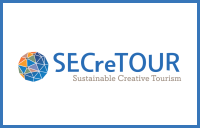-
Join the
Digital Meets Culture
Newsletter! -
Join the
Digital Meets Culture
Open Newsroom! If you have interesting news and events to point out in the field of digital cultural heritage, we are waiting for your contribution.
If you have interesting news and events to point out in the field of digital cultural heritage, we are waiting for your contribution.
-
Free text
-
-
Upcoming events
-
 Collaboration agreement has started between CREATOUR Observatory at the Centre for for Social Studies, University of Coimbra, in November 2024
Collaboration agreement has started between CREATOUR Observatory at the Centre for for Social Studies, University of Coimbra, in November 2024The SECreTour Network is growing! The SECreTour project has established a new collaboration with CREATOUR® Observatory on culture and tourism for local development at the Centre for Social Studies, University of Coimbra, Portugal. The CREATOUR Observatory is an internationally recognized … Continue reading →
 Following the presentation at PPAM 2024, "Cultural Heritage 3D Object Management with Integrated Automation Workflows" will be published on FGCS journal
Following the presentation at PPAM 2024, "Cultural Heritage 3D Object Management with Integrated Automation Workflows" will be published on FGCS journalThe Lambousa Fishing Boat case and the data managing within the scope of EUreka3D project was presented by Michał Orzechowski at the 15th International Conference on Parallel Processing & Applied Mathematics. Following the presentation, Future Generation Computer Systems journal invited … Continue reading →
Topic: history & archaeology

The Smithsonian’s Digitization Program Office has developed 3D models from its holdings, and a selection of models is available online. The Smithsonian x3D Explorer allows users to interact with the digital objects in a web browser, to access, view and manipulate these objects, and eventually to print them with a in-house 3D printer, as the raw 3D data from the objects will be made available for downloading for personal and non-commercial use. Continue reading

This event was aimed at anyone interested in epigraphy (digital or non-digital) as well as to the establishment and diffusion of general best current practices for digital editions. It covered many aspects of digital technology applied to inscriptions, from content to management and networking. It was composed of 3 workshops (Harmonization and interoperability of Inscriptions, Translations of Inscriptions, Intellectual Property Rights) and a photographic workshop on shooting high quality images for online publication and research. Continue reading

Organized by the Archeology of Photography Foundation, the National Museum in Warsaw and the national Institute of Museology and Collections protection, the seminar included a panel of international speakers. “Bringing together an array of internationally renowned speakers, the conference provided ample platform for debate and creative comparison”, said the organizers. Continue reading

Alongside the great new logo, EAGLE have also launched their website and project tagline – ‘A digital bridge to the ancient world’. The rich, detailed and intuitive website (www.eagle-network.eu) contains all the information relevant to the project, including contact information, upcoming events and schedules, and a detailed description of partner institutions and their contributions. Continue reading

The event is very wide. For this reason, to provide an effective way for participants to explore such a rich and diverse program, Digital Heritage 2013 built an interactive schedule featuring social networking, a personal agenda builder, dynamic attendee directories, and more. Users can view the schedule in list, grid, and other forms as well as on mobile devices. Continue reading

Europeana Professional recently published an interesting article related to Eagle project, a best practice network that brings together the most prominent European institutions and archives in the field of Classical Latin and Greek epigraphy to provide Europeana with a comprehensive collection of unique historical sources which constitute a veritable pillar of European culture. Continue reading

The annual event organized by Polis (Polo di Innovazione delle Tecnologie per la Città Sostenibile – Innovation Pole of the Technologies for a Sustainable City) was held in the Engineering College of Siena’s University on the 26th – 27th September 2013. It has hosted two days of debate about the “Smart Specialization Strategy” general topic, structured on the three Polis themes MOBILITY, CULTURAL HERITAGE and SUSTAINABLE BUILDING. Continue reading

Medelhavsmuseet – the Museum of Mediterranean and Near Eastern Antiquities in Stockholm will digitally place human mummies on a virtual autopsy table. The work is taking place in advance of a new exhibition on Egypt, which is due to open in 2014. It will be possible to zoom into very high resolution to see details like carving marks on a sarcophagus, and the true colors of the mummy. The 3D model also allows to “unwrap” a mummy by peeling off virtual layers of the wrapping to explore the mummy itself and the artifacts that were buried with the body. Continue reading





























